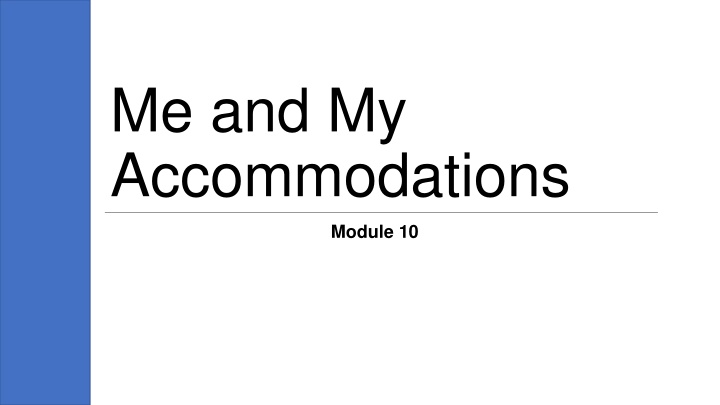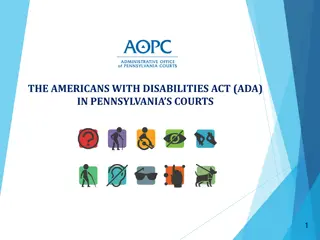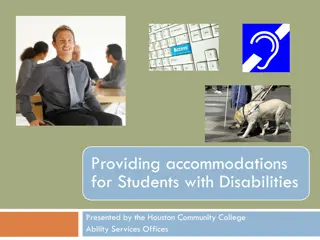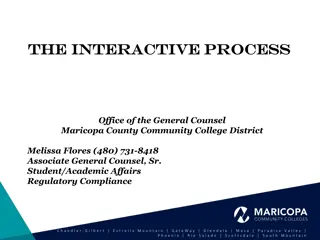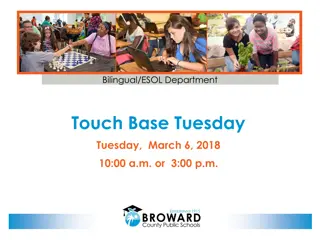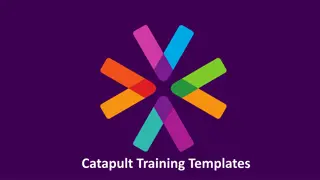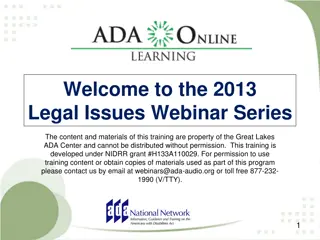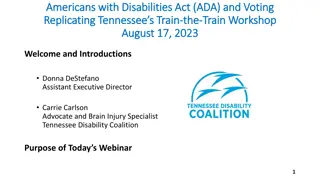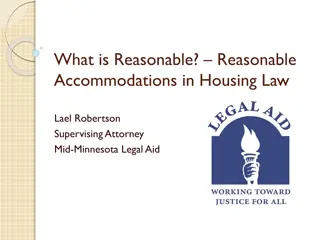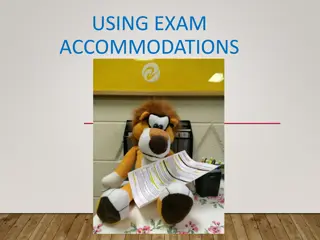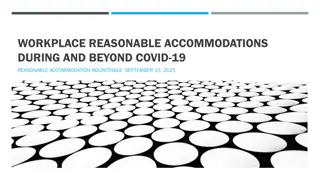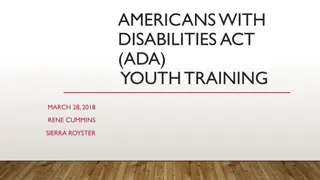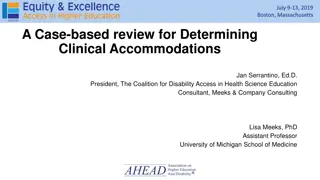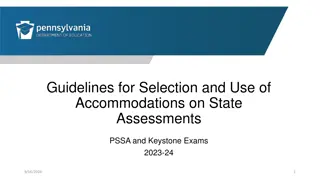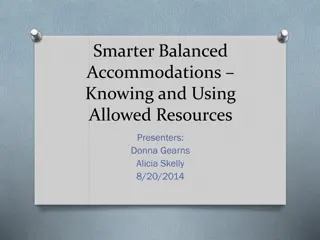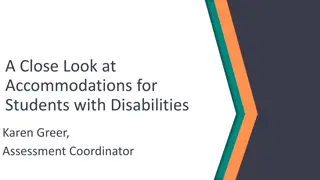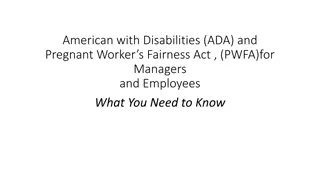ADA Accommodations for Equal Access to Healthcare
The Americans with Disabilities Act (ADA) ensures equal access to healthcare for people with disabilities by removing barriers and providing accommodations. Learn about ADA, common barriers faced in healthcare settings, examples of accommodations, how to make a request, and what to do after making a request for accommodations.
Download Presentation

Please find below an Image/Link to download the presentation.
The content on the website is provided AS IS for your information and personal use only. It may not be sold, licensed, or shared on other websites without obtaining consent from the author.If you encounter any issues during the download, it is possible that the publisher has removed the file from their server.
You are allowed to download the files provided on this website for personal or commercial use, subject to the condition that they are used lawfully. All files are the property of their respective owners.
The content on the website is provided AS IS for your information and personal use only. It may not be sold, licensed, or shared on other websites without obtaining consent from the author.
E N D
Presentation Transcript
Me and My Accommodations Module 10
The ADA What is the ADA? The ADA stands for Americans with Disabilities Act. It is a federal law that helps people with disabilities to not be discriminated against because of their disability. One of the ways that it does this is by helping remove barriers so that people with disabilities can participate more fully in their community. What are some barriers you have faced at your doctor s office or while setting up your appointment?
Examples of Barriers Stairs without a ramp Waiting areas with no space for a wheelchair Presentations or classes with no interpreters or captioning
Accommodations We all have the right to the equal access of health care. An accommodation is a tool, service, or way of doing things that can help a person with a disability complete a task. The doctor may need to provide accommodations so that people with disabilities can have equal access to services. What are some accommodations that you have needed to ask for?
Examples of Accommodations Qualified sign language interpreters Large print materials Enough space for a wheelchair to move around as needed
Making an Accommodation Request When to ask: Ask when you are making your appointment. Try to give your doctor as much time as possible so they can set up your accommodation for you.
What to Say State your specific needs Give examples of things that have worked for you before Share accommodations that have not worked for you in the past
How to Ask Ask for your accommodation in a way that works for you, you can: Call your doctors office Talk with them in person Write an email or letter
After You Make Your Accommodation Request Your doctor should respond without making you wait too long. If the doctor says they will get back to you, ask how long it will take. If you haven t heard back from them by the time they told you, contact them again. Sometimes, a doctor will offer an accommodation that is different that what you asked for. You decide if what they offered will work for you. If it will not work, tell the doctor the reasons why your specific accommodation is best for you
What To Do If You Do Not Receive Your Accommodation Ask to speak with a Disability Access Coordinator Or ADA coordinator, or a patient advocate Let them know what accommodations you need.
Other Types of Accommodations If you need more time: An extra long appointment or two appointments Modified breaks or longer breaks A checklist to help you stay on task
Communication Accommodations Telephone calls instead of e-mails Information provided in writing is written in plain language Information in audio format Plain language used when spoken Emails instead of telephone calls Assistance with reading and writing to fill out forms If your communication style is more visual, you may ask for: Diagrams, models, pictures to communicate ideas Color coding use to identify specific documents
More Types of Accommodations Other communication accommodations: Telephone calls instead of e-mails Information provided in writing is written in plain language Information in audio format Plain language used when spoken Emails instead of telephone calls Assistance with reading and writing to fill out forms
Sensory Accommodations White noise machines to reduce distractions Dimmable, natural, or full spectrum room lighting instead of fluorescent Your support person to be with you always Ask the medical professional to tell you when they are going to touch you
The following slides show 5 stories of people advocating for their accommodations Option for discussion after each slide*
Omar advocated for what he needed. He asked the following questions: Is the building accessible? Is there an accessible exam table? If not, is there a Hoyer lift or transfer team? Is the bathroom accessible and ADA compliant? In the exam room is there enough room for me, my wheelchair, and a support person?
Tanisha did the following steps to ensure a successful appointment: Requested a longer appointment so that she d have more time to communicate with the doctor E-mailed the doctors office asking for the forms she would need to fill out so she could fill them out at home Met with her support person before her appointment and programmed all her questions into her communication device Asked the doctor to speak to her directly At the end of the appointment, Tanisha asked the doctor to email her the summary of her visit and they set up her next appointment.
Sebastian did these things to prepare for this appointment: Requested an exam room without bright lights or noises Let the doctors office know that he would be bringing a support person Wrote down several questions to ask his doctor, with his support person Practiced asking his doctor questions by role playing with his support person. During the appointment, Sebastian Reminded the doctor to speak directly to him Asked the doctor his prepared questions
Kate took the following steps to ensure that her appointment was successful: Used the telephone relay service to make her appointment While making the appointment, she requested a qualified sign language interpreter that is medically qualified Reminded the doctor to speak directly to her and not her interpreter After the visit, Kate followed up with her doctor through email and asked a few more questions.
Vu has a good physical therapist appointment by doing the following: Making sure that Rocket, Vu s guide dog, stays close by Vu and does not make a mess in the hospital Making sure that the physical therapist and staff know that they should not talk to, feed, pet, or play with Rocket
What did I learn? I can take charge of my health care when I: Know my rights under the ADA Know what accommodations are best for me and how to ask for them Know it is my right to tell my health professional what I need for a successful visit
Created in partnership with: Oregon Self Advocacy Coalition, Oregon Health and Science University, and Oregon Council on Developmental Disabilities Northwest ADA Center The toolkit and its components were supported in part by the Grant or Cooperative Agreement Number DD000014, funded by the Centers for Disease Control and Prevention and by the University Center Excellence in Developmental Disabilities Administration on Community Living Grant #90DDUC0039-03-02. Its contents are solely the responsibility of the authors and do not necessarily represent the official views of the Centers for Disease Control and Prevention, Administration on Community Living, or the Department of Health and Human Services.
